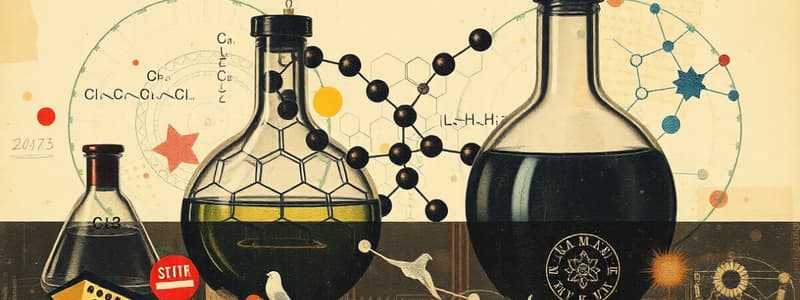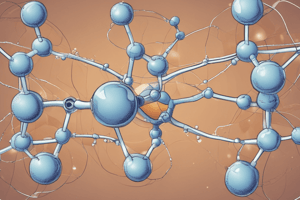Podcast
Questions and Answers
Which type of bonding is characterized by the electrostatic attraction between positive metal ions and delocalized electrons?
Which type of bonding is characterized by the electrostatic attraction between positive metal ions and delocalized electrons?
- Covalent bonding
- Ionic bonding
- Metallic bonding (correct)
- Hydrogen bonding
Ionic bonds are typically formed between two non-metal atoms.
Ionic bonds are typically formed between two non-metal atoms.
False (B)
What type of intermolecular force is primarily responsible for the high boiling point of water?
What type of intermolecular force is primarily responsible for the high boiling point of water?
Hydrogen bonding
In a covalent bond, atoms ______ electrons to achieve a stable electron configuration.
In a covalent bond, atoms ______ electrons to achieve a stable electron configuration.
Which of the following properties is characteristic of ionic compounds in the solid state?
Which of the following properties is characteristic of ionic compounds in the solid state?
Diamond is a good conductor of electricity due to its delocalized electrons.
Diamond is a good conductor of electricity due to its delocalized electrons.
What is the primary difference between a polar and a nonpolar covalent bond?
What is the primary difference between a polar and a nonpolar covalent bond?
The shape of a molecule with four bonding pairs of electrons around the central atom is described as ______.
The shape of a molecule with four bonding pairs of electrons around the central atom is described as ______.
Which type of intermolecular force is present in all molecules, regardless of polarity?
Which type of intermolecular force is present in all molecules, regardless of polarity?
A triple covalent bond involves the sharing of three electrons between two atoms.
A triple covalent bond involves the sharing of three electrons between two atoms.
What property of metals makes them suitable for use in electrical wiring?
What property of metals makes them suitable for use in electrical wiring?
According to VSEPR theory, lone pairs of electrons around a central atom exert ______ repulsion than bonding pairs.
According to VSEPR theory, lone pairs of electrons around a central atom exert ______ repulsion than bonding pairs.
Which molecule is expected to have the highest boiling point?
Which molecule is expected to have the highest boiling point?
Electronegativity is the measure of an atom's ability to attract protons in a chemical bond.
Electronegativity is the measure of an atom's ability to attract protons in a chemical bond.
Why does graphite conduct electricity while diamond does not?
Why does graphite conduct electricity while diamond does not?
Van der Waals forces are also known as ______ forces.
Van der Waals forces are also known as ______ forces.
Which of the following molecules is nonpolar, even though it contains polar bonds?
Which of the following molecules is nonpolar, even though it contains polar bonds?
Molecules with stronger intermolecular forces generally have lower boiling points.
Molecules with stronger intermolecular forces generally have lower boiling points.
What is the shape of a molecule with two bonding pairs and two lone pairs around the central atom?
What is the shape of a molecule with two bonding pairs and two lone pairs around the central atom?
Match the bond type with its description:
Match the bond type with its description:
Flashcards
Chemical bond
Chemical bond
The attractive forces that hold atoms together.
Ionic bond
Ionic bond
Electrostatic attraction between oppositely charged ions, formed by electron transfer.
Cations
Cations
Ions with positive charge, formed when metals lose electrons.
Anions
Anions
Signup and view all the flashcards
Covalent bond
Covalent bond
Signup and view all the flashcards
Single covalent bond
Single covalent bond
Signup and view all the flashcards
Double covalent bond
Double covalent bond
Signup and view all the flashcards
Simple molecular structures
Simple molecular structures
Signup and view all the flashcards
Giant covalent structures
Giant covalent structures
Signup and view all the flashcards
Metallic bond
Metallic bond
Signup and view all the flashcards
Intermolecular forces
Intermolecular forces
Signup and view all the flashcards
Van der Waals forces
Van der Waals forces
Signup and view all the flashcards
Dipole-dipole interactions
Dipole-dipole interactions
Signup and view all the flashcards
Hydrogen bonding
Hydrogen bonding
Signup and view all the flashcards
Bond polarity
Bond polarity
Signup and view all the flashcards
Electronegativity
Electronegativity
Signup and view all the flashcards
δ+ (Partial Positive Charge)
δ+ (Partial Positive Charge)
Signup and view all the flashcards
δ- (Partial Negative Charge)
δ- (Partial Negative Charge)
Signup and view all the flashcards
VSEPR theory
VSEPR theory
Signup and view all the flashcards
Linear Shape
Linear Shape
Signup and view all the flashcards
Study Notes
- Chemical bonds are attractive forces that hold atoms together.
Ionic Bonding
- Ionic bonding is the electrostatic attraction between oppositely charged ions.
- It occurs after the transfer of electrons from one atom to another.
- Ionic bonds typically form between metals and non-metals.
- Metals lose electrons to form positive ions (cations).
- Non-metals gain electrons to form negative ions (anions).
- The resulting ions have stable electron configurations, usually with a full outer shell (octet rule).
- Example: Sodium chloride (NaCl) is formed by the transfer of an electron from sodium (Na) to chlorine (Cl).
- Ionic compounds form giant ionic lattices.
- Physical properties of ionic compounds:
- High melting and boiling points due to strong electrostatic forces.
- Conduct electricity when molten or dissolved, as ions are free to move.
- Often soluble in polar solvents.
- Tend to be brittle.
Covalent Bonding
- Covalent bonding is the sharing of electron pairs between atoms.
- It occurs when atoms need to gain electrons to achieve a full outer shell but neither atom is able to fully remove electrons from the other.
- Covalent bonds typically form between non-metals.
- Shared electrons are attracted to the nuclei of both atoms, holding them together.
- A single covalent bond involves one shared pair of electrons.
- A double covalent bond involves two shared pairs of electrons.
- A triple covalent bond involves three shared pairs of electrons.
- Example: Methane (CH4) has four single covalent bonds between carbon and hydrogen.
- Covalent compounds can form simple molecular structures or giant covalent structures.
Simple Molecular Structures
- Simple molecular structures consist of a fixed number of atoms covalently bonded together.
- There are weak intermolecular forces between molecules.
- Physical Properties of simple molecular structures:
- Low melting and boiling points due to weak intermolecular forces
- Don't conduct electricity because they have no mobile ions or delocalised electrons
- Often insoluble in water
Giant Covalent Structures
- Giant covalent structures consist of a large network of covalently bonded atoms.
- Examples: Diamond, graphite, silicon dioxide (SiO2).
- Physical properties of giant covalent structures:
- High melting and boiling points due to strong covalent bonds throughout the structure.
- Diamond is very hard and doesn't conduct electricity.
- Graphite conducts electricity due to delocalized electrons between layers.
- Graphite has layers that can slide over each other, making it slippery.
Metallic Bonding
- Metallic bonding is the electrostatic attraction between positive metal ions and delocalized electrons.
- It occurs in metals.
- Metal atoms lose their outer electrons, forming positive ions.
- The released electrons become delocalized, forming a "sea" of electrons around the metal ions.
- The delocalized electrons are free to move throughout the structure.
- Metals form giant metallic lattices.
- Physical properties of metals:
- High melting and boiling points due to strong metallic bonds.
- Conduct electricity and heat due to delocalized electrons.
- Malleable and ductile because the layers of ions can slide over each other without breaking bonds.
- Lustrous (shiny) due to the reflection of light by delocalized electrons.
Intermolecular Forces
- Intermolecular forces are weak attractive forces between molecules.
- They are much weaker than covalent or ionic bonds.
- Types of Intermolecular Forces:
- Van der Waals forces (London Dispersion Forces)
- Present in all molecules.
- Temporary dipoles are caused by momentary uneven distribution of electrons.
- Larger molecules have stronger London dispersion forces.
- Induced dipole-dipole interactions
- Dipole-Dipole interactions
- Occurs between polar molecules.
- Stronger than London dispersion forces.
- Positive end of one polar molecule attracts the negative end of another.
- Hydrogen Bonding
- Strongest type of intermolecular force.
- Occurs between molecules containing hydrogen bonded to a highly electronegative atom (oxygen, nitrogen, or fluorine).
- Hydrogen atom is attracted to a lone pair of electrons on the electronegative atom of another molecule.
- Van der Waals forces (London Dispersion Forces)
Bond Polarity
- Bond polarity is the unequal sharing of electrons in a covalent bond.
- It arises when the atoms in a covalent bond have different electronegativities.
- Electronegativity is the ability of an atom to attract electrons in a covalent bond.
- A polar bond has a dipole, with a partial positive charge (δ+) on one atom and a partial negative charge (δ-) on the other.
- If the electronegativity difference is large enough, the bond becomes ionic.
- Nonpolar bond: electrons shared equally.
- Polar bond: electrons shared unequally, resulting in a dipole moment.
- Example: In water (H2O), oxygen is more electronegative than hydrogen, so the O-H bonds are polar.
Shapes of Molecules
- Valence Shell Electron Pair Repulsion (VSEPR) theory predicts the shapes of molecules based on the repulsion of electron pairs around a central atom.
- Electron pairs repel each other and position themselves as far apart as possible to minimize repulsion.
- Electron pairs can be bonding pairs (shared in covalent bonds) or lone pairs (non-bonding).
- Lone pairs repel more strongly than bonding pairs, affecting the bond angles.
- Common molecular shapes:
- Linear: Two electron pairs around the central atom (180° bond angle). Example: Carbon dioxide (CO2).
- Trigonal planar: Three electron pairs around the central atom (120° bond angle). Example: Boron trifluoride (BF3).
- Tetrahedral: Four electron pairs around the central atom (109.5° bond angle). Example: Methane (CH4).
- Pyramidal: Three bonding pairs and one lone pair around the central atom (approximately 107° bond angle). Example: Ammonia (NH3).
- Bent or V-shaped: Two bonding pairs and two lone pairs around the central atom (approximately 104.5° bond angle). Example: Water (H2O).
- Octahedral: Six electron pairs around the central atom (90° bond angle). Example: Sulfur hexafluoride (SF6).
Studying That Suits You
Use AI to generate personalized quizzes and flashcards to suit your learning preferences.




